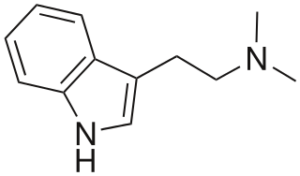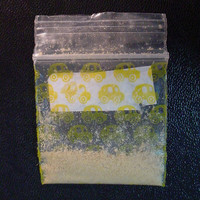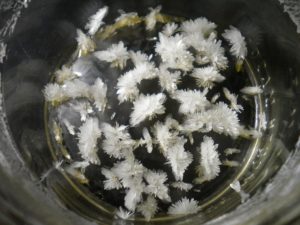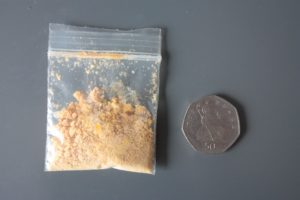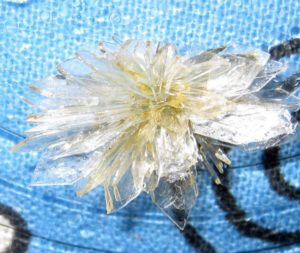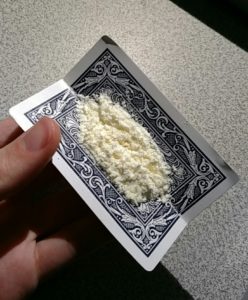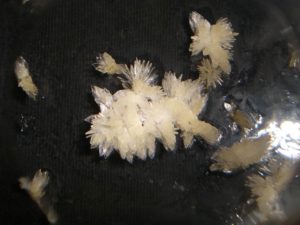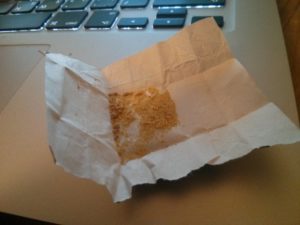Dimethyltryptamine (DMT) is an intense naturally-occurring psychedelic that’s also found endogenously in the human body. It’s not as popular as LSD or psilocybin, though its use has grown over time.
The most popular route of administration is inhalation, but it’s also frequently taken orally in ayahuasca-like preparations.
It has at least been used for centuries.
Dimethyltryptamine = N,N-Dimethyltryptamine; DMT; N,N-DMT; Dimitri
PubChem: 6089
Molecular formula: C12H16N2
Molecular weight: 188.274 g/mol
IUPAC: 2-(1H-indol-3-yl)-N,N-dimethylethanamine
Contents
Dose
Inhalation (most common route of administration)
Light: 10 – 20 mg
Common: 20 – 40 mg
Strong: 40 – 60 mg
Oral
Common: 30 – 60 mg
DMT is typically inactive orally. This changes when it is combined with an MAOI. An example of this combination is ayahuasca, which contains Banisteriopsis caapi (MAOIs) and Psychotria viridis (DMT).
An analysis of 16 ayahuasca preparations found the following concentrations per 100 mL:
- Beta-carboline (MAOI) average: 158 mg
- Range: 20 – 401 mg
- DMT average: 29 mg
- Range: 25 – 36 mg
Another analysis yielded a similar result, with a 100 mL dose providing an average of 24 mg of DMT.
The concentrations in ayahuasca can vary significantly.
Timeline
Inhalation
Total: 10 – 15 minutes
Onset: Under 30 seconds
The effects can begin in as little as 15 seconds. Peak effects arrive between 1 and 2 minutes.
Oral
Total: 3 -4 hours
Onset: 00:30 – 00:45
Experience Reports
Effects
Positive
- CEVs and OEVs
- Spiritual or otherwise meaningful experiences
- Euphoria
- Mood lift
- Auditory hallucinations
Negative
- Increased heart rate
- Increased blood pressure
- Fear
- Anxiety
- Paranoia
Full dose experiences
Taking DMT at a full dose (one capable of yielding a “breakthrough” experience) leads to highly variable effects. Although there’s a lot of variation, we can place the effects/experiences into groups and a general outline can be provided.
Among the common elements of an experience are:
- Full replacement of normal reality with an “alternate universe.”
- This may contain visual effects as well as seemingly sentient, intelligent, or powerful entities.
- Complex rapidly changing “kaleidoscopic” imagery
- Present with eyes open or closed.
- Colors are frequently said to be brighter and more intense than when sober.
- Some auditory changes, mainly in the form of distortions.
- Whining, whizzing, and crinkling sounds.
- Whispers are sometimes reported.
- Auditory effects are less common and less prominent than the visual alterations.
- Dissociation from the body and a disconnection from normal reality.
- The experience is ineffable.
- It’s difficult to put the effects into language and it may also be difficult to fully remember/process what occurred.
Transient anxiety is often a part of the experience, at least during the beginning portion. This can transform into euphoria, laughter, amazement, and confusion. Even though it’s not the most common response, it’s certainly possible to experience fear and anxiety during the entire effect period.
A user’s sense of time is distorted such that they may not comprehend time or it may feel like they’re in the DMT space longer than they actually are.
Levels of an experience
Benny Shanon’s stages of the DMT experience
The stage you reach depends on factors like dose and personal response.
- Bursts, puffs and splashes of colour
- Repetitive, multiplying non-figurative elements
- Geometric designs and patterns
- Designs with figures
- Rapid figurai transformations
- Kaleidoscopic images
- Well-defined, stable, single figurative images
- Proto-scenes
- Full-fledged scenes
- Interactive scenes
- Scenes of flight
- Celestial and heavenly scenes
- Virtual reality
- Supreme light
Rick Strassman’s categories
Strassman grouped the experiences by their potential core thematic element.
- Personal – Encounters with one’s own personal issues, often difficult to accept.
- Transpersonal – An experience novel in intensity and quality but formed from the subject’s previous experience. May be a mystical or near-death-type experience.
- Invisible worlds – Encounter with autonomous, freestanding realities sometimes appearing to be inhabited by alien beings capable of interaction.
He reported over half of volunteers given a high-dose had at least one “invisible worlds” experience.
Progression timeline
When the effects first take hold they tend to be described as an energetic “rush” and vibration. People report it feels like they’re being rocketed to a new location.
Your head may feel like it’s intensely vibrating. Coinciding with this effect may be sounds, usually of a high-pitch, such as whining, crinkling, or crunching.
The initial period can contain transient anxiety.
From here, the user progresses towards a detachment and dissociation from their body and environment. This leads to a breakthrough which is sometimes preceded by a short waiting period.
Waiting period
While this isn’t present for everyone, there’s sometimes a short transition phase between the “rush” and the actual breakthrough. During this period you may see complex imagery and feel like your moving, such as heading down a tunnel.
It’s possible for someone to end at this phase, often with the feeling that they’ve just barely missed entrance to a complete experience.
Examples
Once someone is in the full effect period (the breakthrough), here is just a short list of the things that have been reported:
- “Vivid colors”
- “A merry-go-round with people in 1890s outfits”
- “Clowns”
- “Circus imagery”
- “A sense of annihilation of personal identity”
- “Feeling loves”
- “Realer than real”
- “Reptilian or insectoid alien beings”
- “High-tech machine-like objects”
- “Crocodiles raping and crushing the experiencer”
- “A great, impersonal power behind all things”
- “A ballroom with crystal chandeliers”
- “A fantastic bird”
- “The inside of a computer’s boards”
- “DNA double helices”
Entities
The entities can appear in many ways. Here are some examples: dwarfs, elves, imps, spirits, gods, stick figures, clowns, reptiles, mantises, bees, spiders, and cacti.
Some users report there’s just a “presence” of an entity.
How they interact with the user varies. Sometimes they’ll laugh and welcome the user. Other times they’ll probe and examine the user. And in some cases there is no interaction.
Much of the time they’re benign or considered helpful, but they can occasionally be antagonistic.
It’s often reported the entities don’t feel like a part of the user. This may just be a feeling.
Users frequently describe them as wise, powerful, or loving.
Benny Shanon’s groupings
- Mythological beings – Such as gnomes, elves, fairies, and monsters of all kinds.
- Chimeras or hybrids – Typically half human half animal or transforming or shapeshifting beings, for example human to puma, to tiger, to wolf.
- Extraterrestrials – These are particularly common for some experients and may be accompanied by spacecraft.
- Angels and celestial beings – Usually winged humanlike beings that may be transparent or composed of light
- Semi-divine beings – May appear like Jesus, Buddha, or typically Hindu, Egyptian, or pre-Columbian deities
- Demons, monsters, and beings of death – Such as the angel of death
Low doses
A low dose can lead to mood elevation and anxiolysis, sometimes in the absence of any hallucinogenic activity. Depending on the exact dose, a non-breakthrough amount may also lead to objects vibrating, enhanced colors, and basic geometric designs.
In one study, a dose of 0.05 mg/kg (IV) led to mood elevation without hallucinogenic effects.
Ayahuasca
The term traditionally refers to B. caapi. It’s come to refer to a combination of B. caapi and P. viridis, the latter of which contains DMT.
Using DMT in this form greatly alters the effect. The timeline is extended to 3 – 4 hours and ineffability is usually less prominent. While the peak intensity (in the sense of fully replacing reality with something ineffable) is reduced, it can be as intense or more intense when it comes to the emotional and psychological impact.
Normally the full effects of ayahuasca are overlaid on normal reality, whereas inhaled/injected DMT is far more dissociative.
Medical
There isn’t much data on its potential medical utility and what does exist often involves ayahuasca, not DMT itself.
Some preliminary data suggestive of efficacy exists for anxiety, depression, and addiction. Much more data needs to be collected.
Depression
Animal research in rats found DMT could increase swimming (“antidepressant” effect) in conditions used to look for potential antidepressant effects.
An open-label trial for ayahuasca in patients suffering from depression found it could improve depressive symptoms up to 21 days after one dose.
A preliminary study involving three females found 2 ml/kg of ayahuasca led to a significant decline in HAM-D scores for up to 14 days, but not 28 days.
Anxiety
One study looking at the ritualistic use of ayahuasca for substance dependence noted a correlation with reduced anxiety scores.
Research has also pointed to chronic ayahuasca use being correlated with lower panic, but not state or trait anxiety.
Addiction
There is some evidence for efficacy in addiction, but most of the positive reports are anecdotal.
Informal data from an ayahuasca center in Peru claimed 67% of 175 patients exhibiting substance dependence avoided relapse for 2 years after undergoing the treatment protocol.
An observational study of ayahuasca treatment among First Nations people in British Columbia yielded some positive data. It only involved 12 ayahuasca-naive people who were given ayahuasca during two sessions guided by a traditional healer.
Data from a 6-month follow-up revealed a correlation with significant improvements in ratings of empowerment, mindfulness, hopefulness, life meaning, and outlook.
There were self-reported declines in cocaine, tobacco, and alcohol use.
Endogenous roles
So far there are only proposals about what it could be doing, assuming DMT has an identifiable endogenous role.
Most proposals fall into these groups:
- Connection to altered states of consciousness, psychosis, and dreams
- Connection to immunoregulation, anti-inflammatory action, and neuroprotection.
- Connection to mood, anxiety, and stress regulation.
Tolerance
Tolerance largely doesn’t occur with DMT. It can be used multiple times in a given day.
One study found four closely-spaced DMT doses on the same day didn’t lead to subjective tolerance.
A paper in the 1970s found LSD-tolerant individuals given DMT didn’t display much cross-tolerance.
Chemistry & Pharmacology
Chemistry
DMT is a simple tryptamine hallucinogen. It’s structurally similar to melatonin and serotonin. It’s also similar to other hallucinogens, including 5-MeO-DMT.
The drug is found in humans, other animals, and throughout the plant kingdom. Some popular sources include Psychotria viridis, Diplopterys cabrerana, and Mimosa tenuiflora.
Pharmacology
The primary mechanisms of interest are 5-HTR agonism, Sigma-1 agonism, and TAAR1 agonism.
Serotonin receptors
Binding has been demonstrated at 1A, 1B, 1D, 2A, 2B, 2C, 5A, 6, and 7. Affinities range from 39 nM to 2.1 uM.
Agonism is known to exist at 5-HT1A, 5-HT2A, and 5-HT2C.
5-HT1A isn’t believed to contribute to the psychedelic activity. It could actually work against DMT’s effect. Pindolol, a 5-HT1A partial agonist, was found to increase the effect of DMT by 2-3x in a study of sub-hallucinogenic doses.
5-HT2C isn’t believed to notably contribute to the psychedelic effect. Tolerance also develops at this site. The EC50 for inositol phosphate formation is 49 nM.
5-HT2A is probably a core mediator of the psychedelic effect, but not all actions are attributable to this site. The EC50 is 983 nM.
Sigma-1
DMT is an endogenous Sigma-1 agonist. This is believed to potentially contribute to psychoactivity (although there’s little evidence) and it could also lead to physiological effects.
It has an EC50 of 14 uM. Higher concentrations like 100 uM can lead to voltage-gated sodium channel inhibition tied to Sigma-1 activation.
The required micromolar concentrations of DMT could be achieved with intentional use. Endogenous activity at this site would require some form of storage/release mechanism in the brain (see: “getting into the brain.”)
There’s a hypothetical connection between the Sigma-1 action and antidepressant effects of DMT or ayahuasca. Some antidepressants are indeed high-affinity Sigma-1 agonists.
Agonism at this site may also be neuroprotective.
TAAR1
Activation of TAAR1 has been shown. TAAR1 is more responsive to tyramine and DMT than serotonin. In one rat study, tyramine exhibited nanomolar affinity and 1 uM of DMT was nearly equal to the activity of tyramine.
Since it appears activity is possible with nanomolar concentrations, TAAR1 might be connected to a regulatory action of endogenous DMT on mood and anxiety. It could also contribute to low-dose DMT’s mood effects.
Other
Binding to SERT and VMAT2 has been demonstrated.
- Ki (inhibition of 5-HT uptake)
- SERT: 4 uM
- VMAT2: 93 uM
DMT causes a temporary rise in prolactin, growth hormone, and cortisol.
mGlu2 receptors may be important for DMT’s action as they work presynaptically to reduce glutamate release. An agonist, LY379268, was found to decrease the discriminative stimulus of DMT. An antagonist, LY341495, boosted the impact of low-dose DMT.
mGlu2 colocalizes with 5-HT2a in cortical regions.
Pharmacokinetics
MAO-A typically destroys DMT at a rapid pace. It can become undetectable in blood around an hour after administration.
Two of the primary metabolites are indole-3-acetic acid (IAA) and DMT-N-Oxide. Some of the IAA may be coming from metabolism to N-methyltryptamine.
Pathways other than MAO-A exist and when MAO-A is inhibited, they become more important. For example, when the enzyme is inhibited in rats, there’s a greater formation of DMT-N-Oxide.
This change in metabolism could be useful in studies, including those looking at endogenous DMT. Measuring IAA isn’t particularly helpful given it can come from multiple sources, so it’s useful to measure DMT-N-Oxide.
Endogenous
DMT has been reported to occur naturally in humans and there’s sufficient evidence to say it’s an endogenous chemical. A lot of the reports find it’s sporadically detectable.
Although the finding doesn’t immediately apply to humans, DMT has also been detected in rat pineal gland.
Synthesis
The biosynthesis is believed to begin with tryptophan, which then becomes tryptamine. Through the use of the INMT enzyme, N-methyltryptamine is formed. INMT then catalyzes the final formation of DMT.
Some high expression areas for INMT are the lungs, thyroid, and adrenal gland. The brain generally lacks notable levels, but the pineal gland does have INMT.
Areas that contain INMT also often contain the enzymes necessary to catabolize DMT, limiting the amount that would be released into blood.
Getting into the brain
It’s not clear where the drug is primarily produced, but even if it occurs outside of the brain, there’s a hypothesis for how it may enter and accumulate in the brain.
Under this hypothesis, peripheral DMT would cross the blood-brain barrier (which is known to be possible). It could enter neurons via the serotonin transporter and then enter synaptic vesicles through VMAT2.
This sort of activity, if found to occur, would allow DMT to act in the intracellular space or be released at a larger concentration in response to a given stimuli.
Some support for this hypothesis exists in the form of evidence that DMT isn’t quickly eliminated from the brain after administration. In rats, radiolabeled DMT remained in the brain for at least 7 days post-injection.
History
For centuries or longer
DMT has been used in the form of ayahuasca-like brews and in the form of snuffs. Snuffs typically contain DMT as a minor constituent, not as the primary drug. There is some evidence for snuff use dating back thousands of years.
Europeans reported ayahuasca (possibly just B. caapi) use during the 1700s. Prior to that point, we don’t really have evidence of ayahuasca being used. Based on the available evidence, it’s likely DMT-containing brews have been used for at least a couple centuries, but not necessarily millennia like is often claimed.
Amazonian tribes use ayahuasca (with or without DMT) to receive help from protective spirits, to receive insight into the causes/cures of disease, to see the future, to send messages to other groups, to prepare for war and hunting, and to discover enemies and their intentions.
1900s
Following the Amazon rubber boom, multiple syncretic ayahuasca-using religions appeared in Brazil. They blended Brazilian cosmological beliefs, Catholic and European traditions, and traditional beliefs/knowledge from South America.
Santo Daime appeared in the 1930s. It was formed by Raimundo Irineu Serra, a Brazilian rubber tapper. He encountered the brew through contact with indigenous peoples in Acre, a Brazilian frontier state.
Barquinha formed through a split with Santo Daime in 1945
Santo Daime became more active in urban areas and eventually internationally after the 1970s.
The Uniao de Vegetal (UDV) was formed in 1961 by Jose Gabriel da Costa, who was also a rubber tapper.
1931
DMT was synthesized by Richard Manske, a chemist working in Canada.
1950s – 1960s
Reports of endogenously detectable psychoactive tryptamines began to appear. Bufotenin was initially found, followed by reports of DMT and 5-MeO-DMT.
The INMT enzyme was then detected as well.
Dozens of studies ended up looking at the presence of DMT and other drugs in human biological samples.
1950s – 1960s
Research, initially with snuffs, found that South American peoples were sometimes using combinations of beta-carbolines and DMT. This led to the hypothesis that beta-carbolines activated DMT when used intranasally or orally.
Ultimately this hypothesis was supported by human experiments involving ayahuasca and ayahuasca-like preparations.
1955
DMT was first definitely isolated from a plant. It came from Anadenanthera peregrina, which was used to prepare a snuff.
At least a partial isolation may have occurred in 1946 by Brazilian chemist Oswaldo Goncalves de Lima, who isolated an alkaloid from Mimosa tenuiflora.
De Lima’s work was followed up in 1959 by American researchers who showed DMT’s presence in M. tenuiflora root bark. That source gave a 0.57% yield.
1956
Stephen Szara, a Hungarian biochemist, reported on the hallucinogenic effects of pure DMT for the first time. He synthesized the drug in his lab and injected it.
He then gave it to a couple medical colleagues, which progressed to 30 other individuals, mostly doctors.
One user reported, “the whole room is filled with spirits…I feel exactly as if I were flying.” Another stated, “In front of me are two quiet, sunlit Gods.”
Psychotic individuals were also given DMT in an experiment connected to Szara.
1960s
Although psychedelics rose into the West’s public consciousness at this time, ayahuasca was largely absent. DMT did receive some attention, but it wasn’t one of the most popular psychedelics.
Some discussion about the drug came from Timothy Leary and Ralph Metzner, who tried inhaling and injecting it.
A 1966 article from Leary brought DMT to the attention of quite a few people. It was called, “Programmed Communication During Experiences With DMT.” It included a report from the philosopher Alan Watts.
1967
Six snuffs from South America were examined and found to mainly contain 5-MeO-DMT, with DMT as a secondary drug.
1968
DMT was found in the leaves of Diplopterys cabrerana, an ayahuasca admixture plant in Ecuador.
1970s
Testing confirmed DMT was inactive orally, even when using as much as 1 gram. This was despite significant psychoactivity with IM, IV, and inhalation.
However, people began to find that combining it with an MAOI could lead to effects.
Jeremy Bigwood reported 100 mg of DMT with 86 mg of harmaline was effective. This combination led to:
DMT-like hallucinations…very similar to…a DMT and harmaline-containing ayahuasca brew that I had previously experimented with.
1980s
Further tests with DMT and MAOIs found the combination was reliably effective. A threshold of around 20 mg for DMT was determined, with the ideal amount being 30 – 40 mg or more.
1980s – 1990s
Terence McKenna helped popularize the drug and in particular the inhalation route of administration.
He frequently talked about his experiences and was enthusiastic about DMT.
1990s
Jonathan Ott, an ethnobotanist, reported that combining 120 mg of harmine with 30 mg or more of DMT yielded good effects.
1990s
Rick Strassman, a medical doctor, began investigating DMT. He picked the drug because it was short-acting, naturally occurring, had potentially inadequately explored roles in humans, and was relatively obscure.
He conducted his research at the University of New Mexico Hospital Clinical Research Center.
Dozens of volunteers received hundreds of doses.
His opinions as well as results from the research were presented in DMT: The Spirit Molecule, a book released in 2000. It helped to popularize the substance.
1996
Brazilian law was adjusted to allow for the use of ayahuasca. This followed a legal challenge from the UDV.
2005
The UDV in Brazil was reported to have an estimated 9,000 members, 1,200 of whom were adolescents.
2006
The US Supreme Court ruled the UDV could use their “hoasca” brew despite it containing a Schedule 1 drug. This ruling was based on provisions of the 1993 Religious Freedom Restoration Act that allowed the Native American Church to use peyote.
Similar cases have appeared in other countries.
2000s – 2010s
Interest in the drug increased, partly due to individuals like Joe Rogan, Graham Hancock, and Rick Strassman discussing it. Strassman’s book led to a documentary, DMT: The Spirit Molecule, in 2010.
This has led to more ayahuasca ceremonies in the West, more people travelling to South America to use ayahuasca, more people extracting the drug, and more people using it, generally via inhalation.
2017
LSD and psilocybin remain more popular than DMT, but it has become more common.
Ayahuasca has spread to many countries and has even received some mainstream attention.
DMT is sometimes synthesized, though it’s often extracted from plant sources, something that requires little chemistry knowledge.
Legal Status
US (as of January 2017)
Schedule 1
Other countries (check your local laws)
It is typically illegal.
Laws pertaining to plants vary. They’re often legal to posses, while extracting DMT will usually be illegal.
Safety
Most of the acute concerns are psychological. People with ongoing psychiatric problems would be wise to avoid the drug.
It does increase blood pressure and heart rate, which is something to be aware of if you have a compromised cardiovascular system.
LD50
Mice
- IV – 47 mg/kg (potential human equivalent of 3.81 mg/kg)
- IP – 32 mg/kg (potential human equivalent of 2.59 mg/kg)
Neither of those potential human equivalent LD50s appear accurate, though there’s also no reason to inject ~250 mg of DMT.
Deaths
It doesn’t appear there have been any deaths from DMT alone.
Long-term use
There may be cardiovascular problems associated with heavy chronic 5-HT2b agonism.
Rats exposed to ayahuasca preparations for 14 days showed altered aortic structure, including thickening of the walls of the aorta.
Some of the only available data comes from long-term users of ayahuasca. They often take the drug every other week and have done so for years.
Hoasca Project
An examination of 15 long-term adult members of the UDV in Brazil suggested ayahuasca was not correlated with any negative psychological effects.
Adolescents
40 adolescents from three UDV churches in Brazil were examined. They were 15 to 19-years-old and had taken the drug ritually at least 24 times in the past 2 years.
Most (25/40) began under the age of 13. Only 1 person reported having used ayahuasca outside of a religious context.
39/40 felt their use had a “profoundly positive influence on their lives.”
Testing suggested a non-significant trend towards lower scores for anxiety, self-image problems, and inattentiveness.
Risky Combinations
Stimulants, other psychedelics, and tramadol when using DMT by itself (not ayahuasca).
Overdoses or otherwise problematic cases
Case 1
- 42-year-old male
- No history of psychiatric illness
- Long history of substance use disorders
- 3 weeks pre-admission
- Began using DMT
- Had taken it around 10 times
- Recent stressors included unemployment, eviction from apartment, and death of his mother.
- Brought to ED by police for psychiatric evaluation.
- In ED
- Agitated and underweight
- Agitation addressed with medication.
- Disoriented to time
- Delusional reference of being “navigated by the stars”
- Also religiously themed statements
- Thought processes noted to be loose, disorganized, and tangential.
- Agitated and underweight
- Over next 12 days
- Reported delusions of a paranoid and grandiose manner.
- Said he could read minds and orchestrate distant events/persons by adopting specific body postures.
- Was hyperverbal and intrusive.
- During later interviews
- Said DMT was “real interesting…like traveling to another dimension.”
- Said he interacted with “aliens” on the drug.
- By day 14
- Was denying his previous delusional beliefs, recognizing they were drug-induced.
- Judgement improved.
- Six month follow-up
- Symptom and drug-free.
- TDC opinion
- DMT may or may not have been responsible. If it was, it may have triggered a temporary period of psychosis, which doesn’t seem impossible given the right conditions.
Case 2
- 24-year-old male (South Australia)
- Six months pre-admission
- Developed a complex delusional spiritual belief system and was pursuing enlightenment.
- Wanted to open his internal “third eye.”
- He became aware of DMT through friends, internet forums, and the DMT: The Spirit Molecule documentary.
- Began collecting leaf tips, bark, and seeds from acacia and Phalaris aquatica plants.
- Dried the material, ground it, and then smoked it.
- Plant matter was used with increasing frequency leading up to his presentation with positive symptoms of schizophrenia.
- History of DMT, tobacco, cannabis, and methamphetamine use
- Family history of psychotic illness
- Admitted to hospital for first-episode psychosis
- TDC opinion
- His way of using DMT is atypical. I’m not sure that he would have been exposed to notable levels of DMT by smoking plant material in that way.
Test Videos
References
(2016) Neuropharmacology of N,N-dimethyltryptamine.
(2016) Dimethyltryptamine (DMT): a biochemical Swiss Army knife in neuroinflammation and neuroprotection?
(2015) N,N-Dimethyltryptamine-Induced Psychosis.
(2015) New World Tryptamine Hallucinogens and the Neuroscience of Ayahuasca.
(2014) N, N-Dimethyltryptamine and biological reductive accounts for religious and spiritual experiences
(2012) Does N,N-Dimethyltryptamine (DMT) Adequately Explain Near-Death Experiences?
(2012) Seeing with the eyes shut: neural basis of enhanced imagery following Ayahuasca ingestion.
(2012) Recreational use of naturally occurring dimethyltryptamine – contributing to psychosis?
(2011) Discarnate entities and dimethyltryptamine (DMT): Psychopharmacology, phenomenology and ontology
(2010) Assessment of addiction severity among ritual users of ayahuasca.
(2010) The Hallucinogen N,N-Dimethyltryptamine (DMT) Is an Endogenous Sigma-1 Receptor Regulator
(2009) Dimethyltryptamine (DMT) a Psychedelic
(2009) When the endogenous hallucinogenic trace amine N,N-dimethyltryptamine meets the sigma-1 receptor.
(2008) Identification of N,N-dimethyltryptamine and beta-carbolines in psychotropic ayahuasca beverage.
(2008) Phenomenology of N,N-Dimethyltryptamine Use: A Thematic Analysis
(2007) Ayahuasca in the treatment of Addictions
(2007) Risk assessment of ritual use of oral dimethyltryptamine (DMT) and harmala alkaloids.
(2006) The globalization of ayahuasca: Harm reduction or benefit maximization?
(2005) Ayahuasca in adolescence: a preliminary psychiatric assessment.
(2005) Report on psychoactive drug use among adolescents using ayahuasca within a religious context.
(2005) Drug tourism or spiritual healing? Ayahuasca seekers in Amazonia.
(2005) Endogenous psychoactive tryptamines reconsidered: an anxiolytic role for dimethyltryptamine.
(2005) Ayahuasca in adolescence: a neuropsychological assessment.
(1999) Pharmahuasca: human pharmacology of oral DMT plus harmine.
(1998) Agonist properties of N,N-dimethyltryptamine at serotonin 5-HT2A and 5-HT2C receptors.
(1996) Human psychopharmacology of N,N-dimethyltryptamine.
(1991) Differential interactions of dimethyltryptamine (DMT) with 5-HT1A and 5-HT2 receptors.
(1989) Sociopsychotherapeutic functions of ayahuasca healing in Amazonia.
(1981) N, N-dimethyltryptamine: an endogenous hallucinogen.
(1976) Dimethyltryptamine levels in blood of schizophrenic patients and control subjects.
(1976) DMT & TMA-2
(1973) The effects of N,N-dimethyltryptamine on operant behavior in squirrel monkeys
(1972) “Ayahuasca,” the South American Hallucinogenic Drink: An Ethnobotanical and Chemical Investigation
(1964) The effect of N,N-Dimethyltryptamine in human subjects tolerance to lysergic acid diethylamide










